Cantabria: Una región rica en historia y patrimonio cultural
viernes 24 septiembre 2021La Fundación Camino Lebaniego participa en el proyecto transnacional Atlantic CultureScape, donde se desarrollan experiencias que impulsan la oferta turística a través del patrimonio inmaterial del Área Atlántica. Mediante éste, buscamos dar a conocer la cultura intangible de la que presume nuestra región y mejorarla a través de la colaboración de empresas locales, además de proporcionar un crecimiento económico sostenible para la zona.
Cantabria: A region rich in history and cultural heritage
Cantabria is a region rich in history, reflected in the absorbing culture and heritage that it encompasses. Through this brief review we will make known the intangible heritage that the community boasts, from its most ancestral traditions declared of National and International Tourist Interest as well as its various festivals of pagan and religious origins, which are part of the folklore and seal the community identity.
Among its festivities, we highlight the Coso Blanco Festival, which is celebrated in the fishing village of Castro Urdiales on the night of the first Friday in July. It is a spirited celebration where beautifully crafted striking floats go down the streets of the city, accompanied by music, fireworks and marching bands.
Less than 30 km away, in the municipality of Laredo, the Batalla de Flores festival fills the streets with colour and joy, where glamorous floats made with flowers run through the town, an authentic visual and artistic spectacle.
Going along the coast, we stop in Santoña, where winter becomes colourful and lively with the famous Northern Carnival, full of music, dances and cheerful costumes.
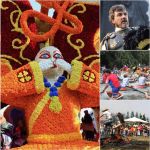
Batalla de Flores festival. Photo: Turismo de Cantabria
We enter the interior valleys of the territory, specifically in Corrales de Buelna, to take a trip back in time and relive one of the most remarkable and exciting battles in the history of the region, the Cantabrian Wars. An outstanding representation of the firm opposition of the Cantabrian natives to the Roman Empire during the period of Caesar Augustus, which draws spectators’ attention and completes the scene with parades of legions, an antiques market, gastronomic exhibitions among other activities of great tourist value.
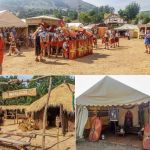
Cantabrian Wars. Photo: Turismo de Cantabria
Continuing through the south of the valleys, another of the most important festivities of the year is La Vijanera, in Silió. It is an ancient tradition to welcome the new year and drive away evil spirits. It is celebrated on the first Sunday of January, and it is considered the first winter masquerade of the year in Europe, which consists of a beautiful ritual related to life and death, where multiple exotic and peculiar masks participate, a tradition that dates back to the time of the Romans.
In all these regions a varied set of aesthetic and artistic manifestations unfolds, in which we can mention traditional dances such as the “jota montañesa” or the “Dance of the Picayos”, accompanied by instruments such as tambourines, bagpipes, or the characteristic rabel, to the sound of the songs that recall the inheritance bequeathed by our predecessors.
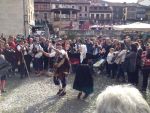
Jota montañesa. Photo: Turismo de Cantabria
It also preserves its own popular crafts that carry a long logging tradition, such as the manufacture of the “albarca” (or wooden clog), and the “cuévano”, a type of pannier, as representatives of objects which are directly linked to a culture connected to the land.
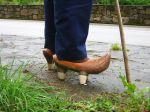
Albarcas

Cuévano
Songs, legends and a unique mythology add greater cultural and historical wealth, which have endured through oral transmission for long generations and embellish our heritage.
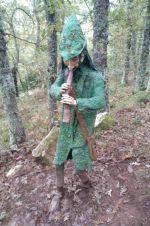
Mythology trail in Peñarrubia
Celebrations around the Lebaniego Way
There are other religious traditions which are of great historical and cultural interest, among them La Vez, in the Monastery of Santo Toribio de Liébana, where from April 16th to the first Sunday in October two people from each town take turns every Friday to worship the relic of the Lignum Crucis, the largest piece of the cross of Christ still preserved.
The devotion to such a precious relic is the focus of other celebrations in the region, such as the Exaltation of the Holy Cross, celebrated on September 14th or the Descent of the Holy Cross to Potes, capital of Liébana, celebrated 50 days after Easter Sunday.
All of them converge on the same common point, the Lignum Crucis, the foundation by which every year thousands of pilgrims from different parts of the country and the world cross our region through the Lebaniego Way or the Northern Way, declared Unesco World Heritage, to get to the renowned monastery.
This is why the Lebaniego Jubilee Year has been celebrated since the 16th century, when April 16th falls on a Sunday, the day of Santo Toribio, in order to meet God and be forgiven of all sins. The next Jubilee Year will take place in 2023 and it will be a time of excitement, exhilaration and deep connection.

Santo Toribio's Monastery. Photo: Fundación Camino Lebaniego - Natalia Magdalena
Blog written by Atlantic CultureScape associate project partner Fundación Camino Lebaniego
www.caminolebaniego.com
